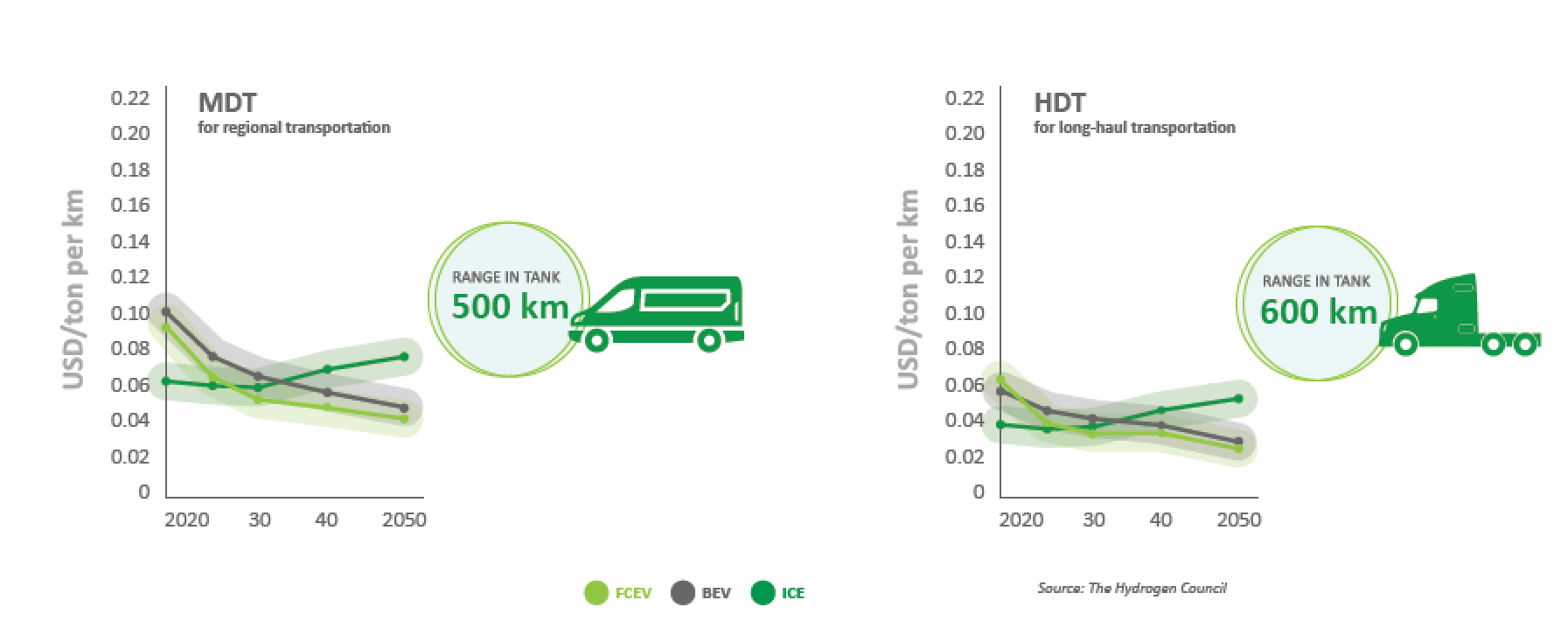To reduce greenhouse gas emissions, improve air quality, and achieve carbon neutrality, tremendous progress has been made in clean energy adoption in recent years, especially for light-duty vehicles. The focus continues to shift toward ambitious climate goals – particularly in the sectors that will have the most impact on meeting them – commercial and industrial vehicles.
Massachusetts (Nuvera headquarters’ home state) has joined 14 other states and the District of Columbia in a Memorandum of Understanding (MOU) to increase the market for zero-emission medium- and heavy-duty vehicles (MHDVs). The MOU sets a goal for 100% zero-emission vehicle sales by 2050, and aims to electrify the transportation sector by promoting mass adoption of zero-emission technologies, including battery electric (BEV), plug-in hybrid (PHEV), and fuel cell electric vehicles (FCEV).
With MHDVs the largest source of transportation sector GHG emissions after light-duty vehicles, it’s clear that providing alternatives to diesel propulsion is vital to meeting the carbon-reduction targets being adopted by central and local governments worldwide, including in many states like Massachusetts that are leading the way for clean transportation.
To reach the goal stated in the MOU of electrifying MHDVs over the coming decades, hydrogen fuel cells play a particularly important role. While hydrogen is a good option for many motive applications, it is especially well-suited for vehicles used intensively. In fact, when it comes to long-haul scenarios like those of trucking fleets, fuel cells may be the only viable emission-free option.
Not only are fuel cell-powered MHDVs ideal for the long routes typically found in goods movement operations, but the shorter refueling time compared to electric battery charging is a clear advantage. The fueling cost differential between FCEVs and BEVs is narrowing considerably, and a recent analysis from Bloomberg reports that cost for hydrogen is expected to fall by up to 80% by 2030. Demand for hydrogen has grown rapidly over the past few years and will likely continue to accelerate over the next decade. Total cost of ownership for FCEVs is expected to be lower than for either diesel or for battery electric, according to The Hydrogen Council.

The multi-state MOU addressing the changes needed for MHDVs follows on a similar agreement to promote the adoption of clean, light-duty vehicles. In 2013, the governors of eight states, including Massachusetts (later joined by others), signed a MOU committing to ensure the successful implementation of their state’s zero-emission vehicle program and setting a target of 3.3 million ZEVs on the roads in these states by 2025. In 2015, Massachusetts’s governor Deval Patrick formed the Zero-Emission Vehicle Commission “to study the economic and environmental benefits and costs of increased use of zero emission vehicles in the Commonwealth.” Since then, the 27 members of the commission have gone beyond merely acting as a study group, moving on to advocate for the enactment of what became over-subscribed incentive programs and other measures to enable widespread ZEV adoption. Nuvera, Toyota, Air Products and other companies and environmental groups represented on the Massachusetts ZEV Commission have been instrumental in highlighting the unique benefits that fuel cell vehicles of all types bring to communities, and in finding ways to provide both fleet operators and individual vehicle owners access to the technology and fueling infrastructure. These and other activities were explored in depth in a previous blog post.
Nuvera has decades of experience leading fuel cell innovation, and we have always believed that hydrogen represents the future of energy for motive applications. With a focus on industrial fleets, we have worked to develop unique hydrogen technologies integral to the transition toward “carbon neutrality” (i.e. net-zero carbon footprint), and that will benefit commercial operations by enabling higher productivity and reduced cost of ownership compared with battery-powered trucks.
The Nuvera® E-45 Fuel Cell Engine is a product of our experience, innovation, transportation market immersion and long-standing industry involvement. Our engines are designed to be easily integrated with other energy storage systems such as lithium-ion batteries, which provide unique advantages when combined in a fuel cell-powered vehicle. This synergy fits well into the objectives of the governor’s MOU to take advantage of benefits that both fuel cell and battery electric technologies have to offer.
While industrial productivity and concerted regulatory actions are driving the adoption of fuel cells for transportation, there are still challenges that must be addressed before hydrogen can reach its full potential. Most apparent is the need for further financial support to enable significant infrastructural changes (such as hydrogen fueling stations and FCEV travel through tunnels) that will allow for widespread fuel cell MHDV adoption. As Mary D. Nichols, Chair of the California Air Resources Board, recently said:
“For decades, while the automobile has grown cleaner and more efficient, the other half of our transportation system has barely moved the needle on clean air. Diesel vehicles are the workhorses of the economy, and we need them to be part of the solution to persistent pockets of dirty air in some of our most disadvantaged communities. Now is the time – the technology is here and so is the need for investment.”
Governments around the world increasingly understand the importance of a green economic recovery and the job-creation potential of investments in the hydrogen economy. This newest multi-state ZEV MOU is a significant step toward the necessary transition to zero-emission transportation. Nuvera’s innovative fuel cell engines are our latest contribution to driving the industry forward. We’re proud to see Massachusetts at the frontier of this technology revolution, and look forward to joining with the increasing number of states committed to medium- and heavy-duty transport electrification made possible by fuel cells.
